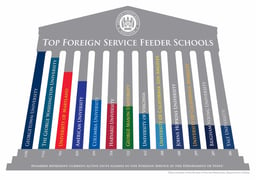American University
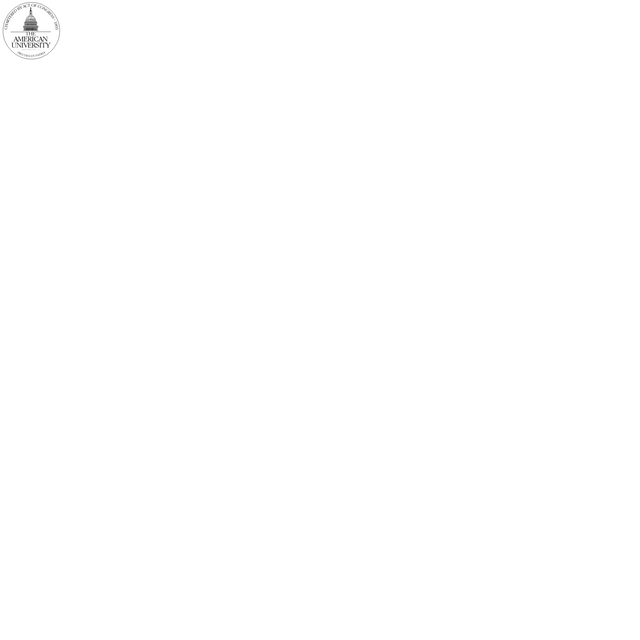
American University

| Motto | Pro deo et patria(Latin) |
|---|---|
| For God and Country | |
| Type | PrivateSpace-grant |
| Established | February 24, 1893 |
| Methodist | |
| Endowment | $708 million (2018)[1] |
| President | Sylvia Mathews Burwell |
| Provost | Daniel J. Myers |
| Students | 13,347 (Fall 2016)[2] |
| Undergraduates | 7,901 (Fall 2016)[2] |
| Postgraduates | 5,446 (Fall 2016)[2] |
| Location | |
| Campus | Urban(Suburban-like Residential Neighborhood) 84 acres (34 ha) |
| Colors | American Red and Blue[3] |
| Athletics | NCAA Division I–Patriot League,MAISA |
| Nickname | Eagles |
| Affiliations | |
| Mascot | Clawed Z. Eagle |
| Website | |
| University rankings | |
| National | |
| Forbes[37] | 126 |
| Times/WSJ[38] | 131 |
| U.S. News & World Report[39] | 77 |
| Washington Monthly[40] | 255 |
| Global | |
| QS[41] | 601–650 |
| Times[42] | 301–350 |
| U.S. News & World Report[43] | 745 |
| Established | 1926 as Battelle Library |
| Location | Washington, D. C. |
| Collection | |
| Size | over 1 million volumes |
| Access and use | |
| Population served | 10,000 students & 1,000 faculty |
| Other information | |
| Director | Nancy Davenport |
| Staff | 72 (full-time) |
| Website | |
| Type | College Television Station |
| Branding | ATV |
| Country | |
| Availability | Washington, D. C. |
| Slogan | Turn us on 24/7 on campus channels 2 & 15 and online[79] |
| WAVE-TV, A-TV2 | |
| 1080i(HDTV)480i(SDTV) | |
| Affiliation | AU Student Media |
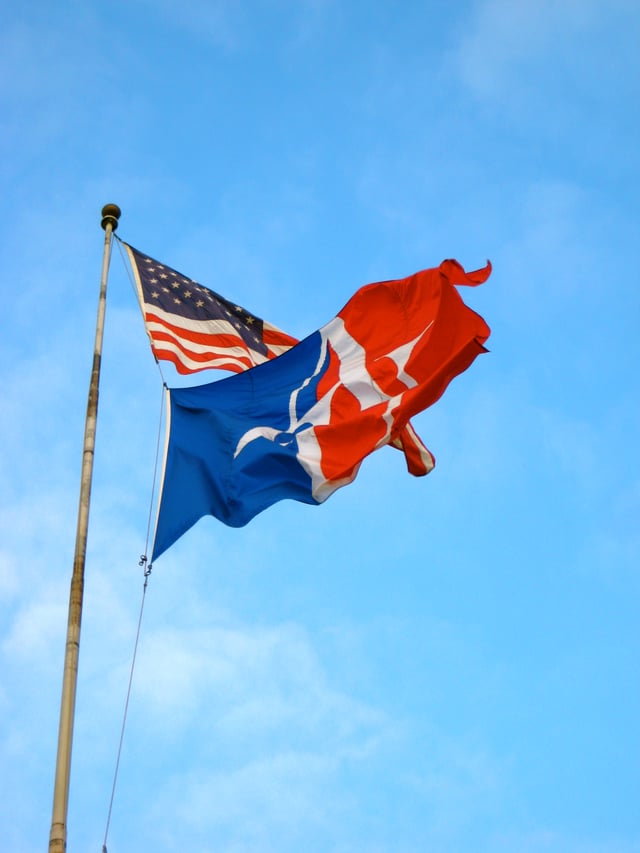
The American University flag
The American University (AU or American) is a private research university in Washington, D.C. Its main campus spans 90 acres (36 ha) at the former site of Fort Gaines on Ward Circle, in the Spring Valley neighborhood in the northwest of the District. AU was chartered by an Act of Congress in 1893 at the urging of Methodist bishop John Fletcher Hurst, who sought to create an institution that would promote public service, internationalism, and pragmatic idealism.[4][5] AU broke ground in 1902, opened in 1914, and admitted its first undergraduates in 1925. Although affiliated with the United Methodist Church, religious affiliation is not a criterion for admission.
American University has eight schools and colleges: the School of International Service, College of Arts and Sciences, Kogod School of Business, School of Communication, School of Professional and Extended Studies, School of Public Affairs, School of Education, and the Washington College of Law (WCL). It has over 160 programs, including 71 bachelor's degrees, 87 master's degrees, and 10 doctoral degrees, as well as J.D., LL.M., and S.J.D programs. AU's student body numbers over 13,000 and represents all 50 U.S. states and 141 countries; around a fifth of students are international. Its prominent alumni include numerous journalists, media personalities, ambassadors, and Congress members. American University is one of the top five feeder schools to the U.S. Foreign Service and other governmental agencies.[6][7] In 2018, The Princeton Review ranked American University 1st for Top Colleges with the Most Politically Active Students.[8]
| Motto | Pro deo et patria(Latin) |
|---|---|
| For God and Country | |
| Type | PrivateSpace-grant |
| Established | February 24, 1893 |
| Methodist | |
| Endowment | $708 million (2018)[1] |
| President | Sylvia Mathews Burwell |
| Provost | Daniel J. Myers |
| Students | 13,347 (Fall 2016)[2] |
| Undergraduates | 7,901 (Fall 2016)[2] |
| Postgraduates | 5,446 (Fall 2016)[2] |
| Location | |
| Campus | Urban(Suburban-like Residential Neighborhood) 84 acres (34 ha) |
| Colors | American Red and Blue[3] |
| Athletics | NCAA Division I–Patriot League,MAISA |
| Nickname | Eagles |
| Affiliations | |
| Mascot | Clawed Z. Eagle |
| Website | |
| University rankings | |
| National | |
| Forbes[37] | 126 |
| Times/WSJ[38] | 131 |
| U.S. News & World Report[39] | 77 |
| Washington Monthly[40] | 255 |
| Global | |
| QS[41] | 601–650 |
| Times[42] | 301–350 |
| U.S. News & World Report[43] | 745 |
| Established | 1926 as Battelle Library |
| Location | Washington, D. C. |
| Collection | |
| Size | over 1 million volumes |
| Access and use | |
| Population served | 10,000 students & 1,000 faculty |
| Other information | |
| Director | Nancy Davenport |
| Staff | 72 (full-time) |
| Website | |
| Type | College Television Station |
| Branding | ATV |
| Country | |
| Availability | Washington, D. C. |
| Slogan | Turn us on 24/7 on campus channels 2 & 15 and online[79] |
| WAVE-TV, A-TV2 | |
| 1080i(HDTV)480i(SDTV) | |
| Affiliation | AU Student Media |
History
Founding

The front gate at American University

American University in 1916
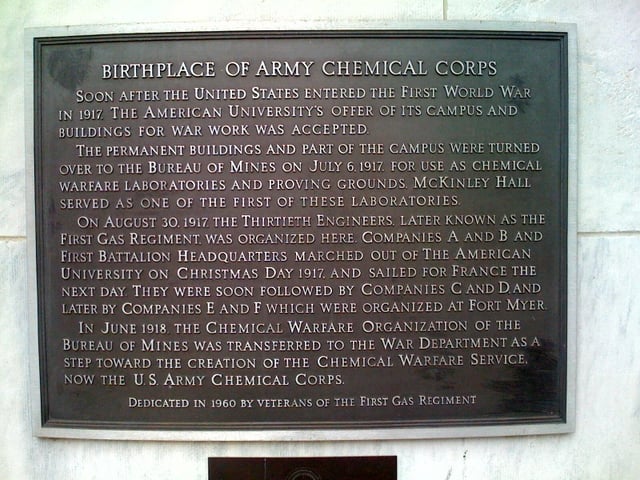
Birthplace of Army Chemical Corps
The American University was established in the District of Columbia by an Act of Congress on December 5, 1892, primarily due to the efforts of Methodist bishop John Fletcher Hurst, who aimed to create an institution that could train future public servants. Hurst also chose the site of the university, which at the time was the rural periphery of the District. After more than three decades devoted principally to securing financial support, the university was officially dedicated on May 15, 1914, with its first instructions beginning October of that year, when 28 students were enrolled, 19 of whom were graduates and the remainder special students not candidates for a degree. The First Commencement, at which no degrees were awarded, was held on June 2, 1915. The Second Annual Commencement was held the following year and saw the awarding of the first degrees: one master's degree and two doctor's degrees. AU admitted both women and African Americans, which was uncommon in higher education at the time. Among its first 28 students were five women, while an African American doctoral student was admitted in 1915.
Shortly after these early commencement ceremonies, classes were interrupted by war.
During World War I, the university allowed the U.S. military to use some of its grounds for testing. In 1917, the U.S. military divided American University into two segments, Camp American University and Camp Leach. Camp American University became the birthplace of the United States' chemical weapons program and the site of chemical weapons testing;[9] this required a major cleanup effort in the 1990s. Camp Leach was home to advanced research, development, and testing of modern camouflage techniques. As of 2014, the Army Corps of Engineers was still removing ordnance including mustard gas and mortar shells.
Instruction was first offered only at the graduate level, in accordance with the plan of the founders.
This changed in 1925 with the establishment of the College of Liberal Arts (subsequently named the College of Arts and Sciences), which offered the first undergraduate degrees and programs. What is now the School of Public Affairs was founded in 1934,[10] partly to educate future federal employees in new approaches to public administration introduced by the New Deal; during the event commemorating its launch, President Franklin D. Roosevelt stressed cooperation between the school and his administration.
AU's relationship to the U.S. government continued during World War II, when the campus hosted the U.S. Navy Bomb Disposal School and a WAVE barracks. For AU's role in these wartime efforts, the Victory ship SS American Victory
1949–1990

President John F. Kennedy delivers the commencement address at American University, June 10, 1963
The post-war period saw considerable growth and restructuring of AU.
In 1947, the Washington Semester Program was established, pioneering the concept of semester-long internships in the nation's capital.
In 1949, the university merged with the Washington College of Law, which had begun in 1896 as the first law school founded by women and the first coeducational institution for the professional study of law in the District. Shortly thereafter, three departments were reorganized as schools: the School of Business Administration in 1955 (subsequently named the Robert P. and Arlene R. Kogod College of Business Administration and in 1999 renamed the Kogod School of Business); the School of Government and Public Administration in 1957; and the School of International Service in 1958.
In the early 1960s, the Department of Defense and the Central Intelligence Agency operated the FFRDC Special Operations Research Office as a think tank at American University. The government abandoned the think tank after its research was criticized as imperialistic by the general public. AU's political involvement was furthered by President John F. Kennedy's Spring 1963 commencement address.[11] In the speech, Kennedy called on the Soviet Union to work with the United States to achieve a nuclear test ban treaty and to reduce the considerable international tensions and the specter of nuclear war during that juncture of the Cold War.
From 1965 to 1977, the College of Continuing Education existed as a degree-granting college with responsibility for on- and off-campus adult education programs.
The Lucy Webb Hayes School of Nursing provided undergraduate study in Nursing from 1965 until 1988.
In 1972, the School of Government and Public Administration, the School of International Service, the Center for Technology and Administration, and the Center for the Administration of Justice (subsequently named the School of Justice) were incorporated into the College of Public and International Affairs.
The university bought the Immaculata Campus in 1986 to alleviate space problems.
This would later become Tenley Campus.
In 1986, construction on the Adnan Khashoggi Sports and Convocation Center began.
Financed with $5 million from and named for Saudi Arabian Trustee Adnan Khashoggi, the building was intended to update athletics facilities and provide a new arena, as well as a parking garage and office space for administrative services. Costing an estimated $19 million, the building represented the largest construction project to date, but met protest by both faculty and students to the university's use of Khashoggi's name on the building due to his involvement in international arms trade.[12]
In 1988, the College of Public and International Affairs was reorganized to create two free-standing schools: the School of International Service and the School of Public Affairs, incorporating the School of Government and Public Administration and the School of Justice.
That same year, construction on the Adnan Khashoggi Sports Center completed while the Iran–Contra Affair controversy was at its height although his name remained on the building until after Khashoggi defaulted on his donation obligation in the mid to late 1990s.
1990–present
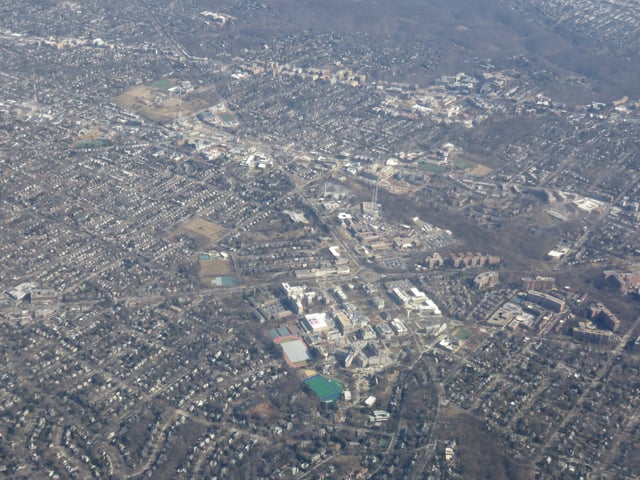
Aerial view of the American University campus, with Tenleytown in the background, in 2019
The School of Communication became independent from the College of Arts and Sciences in 1993.
In 1997, American University of Sharjah, the only coeducational, liberal arts university in the United Arab Emirates, signed a two-year contract with AU to provide academic management, a contract which has since been extended multiple times through August 2009. A team of senior AU administrators relocated to Sharjah to assist in the establishment of the university and guide it through the Middle States Association of Colleges and Schools accreditation process.
In fall 2005, the new Katzen Arts Center opened.
Benjamin Ladner was suspended from his position as president of the university on August 24, 2005, pending an investigation into possible misuse of university funds for his personal expenses. University faculty passed votes of no confidence in President Ladner on September 26.[13] On October 10, 2005, the board of trustees of American University decided that Ladner would not return to American University as its president.[14] Dr. Cornelius M. Kerwin, a long-time AU administrator, served as interim president and was appointed to the position permanently on September 1, 2007, after two outsiders declined an offer from the board of trustees.[15] According to The Chronicle of Higher Education,[16] Ladner received a total compensation of $4,270,665 in his final year of service, the second highest of any university president in the United States.
Ground was broken for the new School of International Service building on November 14, 2007, and completed in 2010.
A speech was given by Senator Daniel K. Inouye (D-HI).
As of the 2017–2018 academic year, a female tuxedo feral cat took up residence on the campus grounds near the McKinley School of Communications building.
School students and staff maintain the cat's small shelter and feeding station and dubbed her "Wonk Cat".[21] Wonk Cat has been adopted by the campus community at large including in university social media postings and her own student-run social media sites.[22]
In 2017, Taylor Dumpson became AU's first female black student body president.
In her first full day in office, bananas were found at three places on campus, hanging from noose-like ropes, and marked with the initials "AKA", which are also the initials of the Alpha Kappa Alpha sorority.
The university considered the incident to be racist, and then-president Neil Kerwin called it a "cowardly, despicable act."
In May 2018, the school said it had exhausted "all credible leads" about who had perpetrated the incident.[23][24]
Also in May 2018, Dumpson filed a lawsuit against a number of people, including Andrew Anglin, the founder of the neo-Nazi website The Daily Stormer. She accused Anglin of organizing a racist and sexist trolling campaign against her.[25] She alleged that Anglin posted her name, her picture, links to her Facebook page, and to the Twitter page of the university's student government, and urged his readers to "troll storm" her, which resulted in many hate-filled and racist online messages directed at her. Although Dumpson and Anglin have not reached a settlement, she settled in December 2018 with one of the people who harassed her, a man from Oregon who was required to apologize, to renounce white supremacy, to stop trolling and doxing online, and to provide information to and cooperate with authorities in the prosecution of white supremacists.[24]
Campus
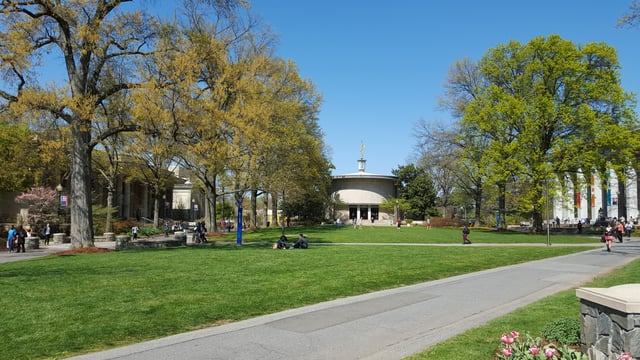
Eric Friedheim Quadrangle

American University
American University has two contiguous campuses used for academics and student housing: the main campus on Massachusetts Avenue, and the East Campus on Nebraska Avenue.
The Washington College of Law has since been moved to the site of the Tenley Campus located in Tenleytown. Additionally, AU owns several other buildings in the Tenleytown, Spring Valley, the East Campus in Wesley Heights, and American University Park areas.
The first design for campus was done by Frederick Law Olmsted but was significantly modified over time due to financial constraints. The campus occupies 84 acres (340,000 m2) adjacent to Ward Circle, the intersection of Nebraska and Massachusetts Avenues. AU's campus is predominantly surrounded by the affluent residential neighborhoods characteristic of the Northwest quadrant of Washington, D. C. The campus includes a main quadrangle surrounded by academic buildings, nine residential halls, a 5,000-seat arena, and an outdoor amphitheatre. The campus has been designated a public garden and arboretum by the American Public Garden Association, with many foreign and exotic plants and trees dotting the landscape.[26]
Academic and recreational buildings
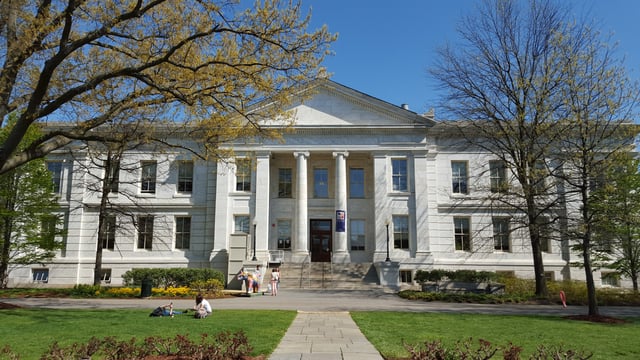
Hurst Hall

Katzen Arts Center
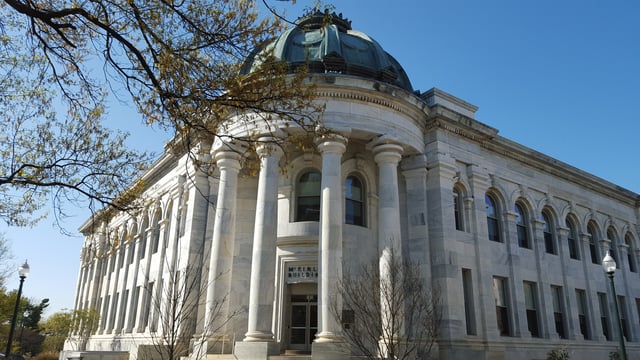
McKinley Building
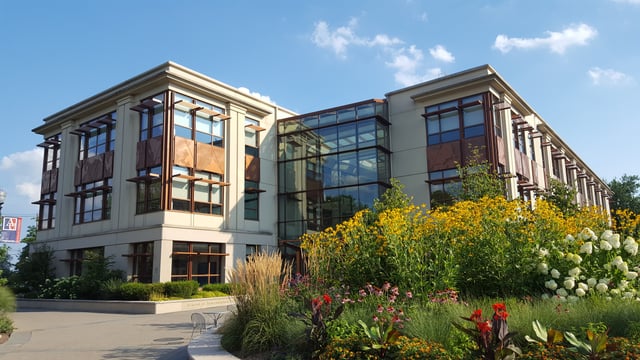
School of International Service
Abbey Joel Butler Pavilion: holds the campus store, the Office of Campus Life, the Career Center, and meeting spaces.
Battelle-Tompkins Building: The university library until 1977 and now home to the College of Arts and Sciences.
Hurst Hall: First building of the university, ground broken in 1896 for what was to be the College of History.
The architects were Van Brunt & Howe. Now home to departments of Biology and Environmental Science, the School of Public Affairs, the University Honors Program, and the Center for Teaching Excellence.
Katzen Arts Center: Provided for by a monetary gift from Cyrus and Myrtle Katzen, the building opened in 2005 and is now home to the Departments of Performing Arts (such as dance), Studio Arts, Graphic Design, and Art History, the American University Museum, and other Academic Departments.
Kay Spiritual Life Center: built in 1963 as a multi-denominational place of worship.
Nicknamed the "flaming cupcake" due its round shape and 16-foot-tall impressionistic flame top, Kay is home to offices of the university chaplains and is used for speeches, performances, and community events.
Kerwin Hall: The largest classroom building on campus, built in 1968 as a home for the School of Government and Public Administration (now the School of Public Affairs).
Kogod School of Business: Formerly known as the Myers-Hutchins Building, and previous home to the Washington College of Law. Construction finished in January 2009 to annex it to the now empty Experimental Theater and Butler Instructional Center.
Mary Graydon Center: Home to student organization offices, the main dining facilities, and the School of Communication.
McKinley Building: Cornerstone laid by President Theodore Roosevelt. Was previously the home of the departments of Computer Science, Audio Technology, and Physics. Has recently become the new home to the School of Communication since newer renovations.
School of International Service: Ground broken by President Dwight Eisenhower. The new building opened for the 2010–2011 school year, with classes continuing to be held also in the original building, which has since been renamed the "East Quad Building", next door. The School of International Service has an enrollment of over 2,000 undergraduate students and an enrollment of over 900 graduate students.[27]
Sports Center: Bender Arena, Reeves Aquatic Center, Jacobs Fitness Center (see Athletics below)
American University (Bender) Library, which holds over a million books.
Residence halls
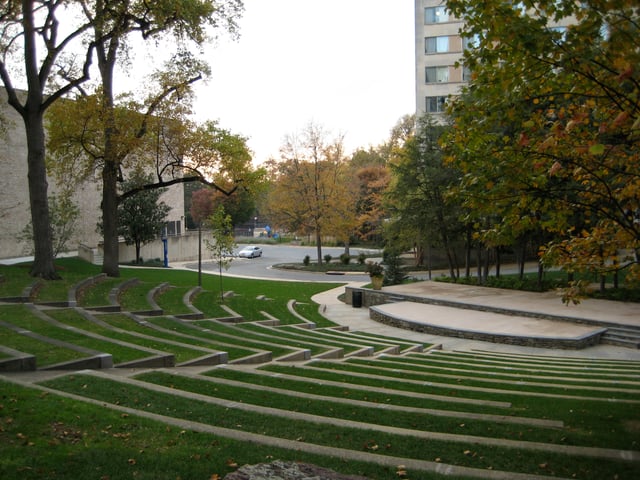
The Woods-Brown Amphitheatre
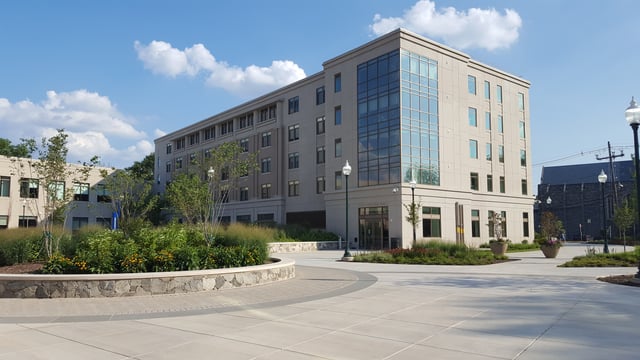
East Campus Residence Hall
Housing is guaranteed for two years.
Most freshman and sophomore students choose to live on campus.
Freshmen are not required to live on campus.
The university recently added 1000 beds in 2013.
Residence halls on the main campus are grouped into three "campuses".
North Campus, commonly referred to as "North Side": Hughes Hall Leonard Hall McDowell Hall Nebraska Hall, located across Massachusetts Avenue from main campus.
It features apartment-style residences.
Cassell Hall, opened for the Fall 2013 semester.[28] This residence hall is equipped with a state of the art 8,000 sq ft (740 m2) fitness facility.[29]
East Campus, completed construction in 2017, includes these halls: Congressional Hall Constitution Hall Federal Hall
South Campus, commonly referred to as "South Side": Anderson Hall Centennial Hall, featuring suite-style living originally intended as housing for upperclassmen.
Clark Hall Letts Hall, named after John C. Letts, university Trustee and President of the Board 1921–1931.
Roper Hall
Tenley Campus
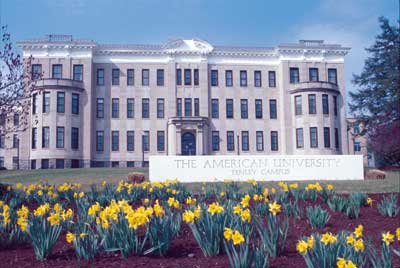
Capital Hall, Tenley Campus, American University
Formerly the Immaculata School, Tenley Campus is located half a mile east of the main campus, and was purchased by American University in 1987 specifically for the Washington Semester program. Tenley Campus used to be home to the Washington Semester and Washington Mentorship Program students, which featured housing primarily for international and transfer students. Before construction of the new Washington College of Law, Tenley Campus was home to the main offices of: the School of Professional & Extended Studies, including the Washington Semester Program, University Marketing and Publications, and the Osher Lifelong Learning Institute. During the summer, the residence halls were used to house students in the Washington Semester - Summer Internship Program.
Since 2016, Tenley Campus has been home to American University's law school, the Washington College of Law. Over the course of several years, former dormitory halls and academic buildings were torn down and replaced with a number of newer, more contemporary academic buildings that now house the Washington College of Law. Ironically, the law school's reputation has fallen sharply since construction began on the new campus. Graduates are reportedly saddled with enormous amounts of debt, and in 2014 only 42% of graduates held jobs that required they pass the Bar.[30]
Recent building expansions
Spring 2014:
Renovation of McKinley Hall into a new home for the School of Communication[31]
2013-Winter 2016:
Demolition of outdated buildings and dormitories on Tenley Campus and construction of new buildings to house the Washington College of Law[32]
Summer 2014-Summer 2017:
Construction of new East Campus development across Nebraska Avenue, composed of three residence halls and two connected academic buildings[33]
Winter 2018-Spring 2019:
Renovation of water pipes across campus.
Construction of new Hall of Science building on previously vacant grassy field on South Side of campus.[34]
Academics
Admissions
Admission to AU is rated as "more selective" by U.S. News & World Report.[35]
For the Class of 2021 (enrolling fall 2017), AU received 19,325 freshmen applications; 5,008 were admitted (25.9%) and 1,082 enrolled.[36] The average high school grade point average (GPA) of the enrolled freshmen was 3.66, while the middle 50% range of SAT scores were 590–690 for critical reading, 560–650 for math, and 570–670 for writing.[36] The middle 50% range of the ACT Composite score was 26–31.[36]
Rankings
American University's undergraduate program was tied for 77th overall among "national universities" in U.S. News & World Report's 2020 rankings, tied for 61st in "Best Undergraduate Teaching", and 82nd in "Best Value Schools".[44]
In 2008, 2010, 2012, and 2018, American University was named the most politically active school in the nation by *The Princeton Review'*s annual survey of college students.[45] In 2006, the Fiske Guide to Colleges ranked AU as a "Best Buy" college for the quality of academic offerings in relation to the cost of attendance. However, in 2013, the Daily Beast listed the school in their list of "20 Least Affordable Colleges".[46] For two years in a row, American University has had more students chosen to receive Presidential Management Fellowships than any other college or university in the country. In spring 2006, 34 graduate and law students were chosen for the honor.[47] American University routinely ranks among the top mid-sized universities for producing Peace Corps volunteers.[48]
Among The Association of Professional Schools of International Affairs (APSIA) schools, AU School of International Service has the largest number of minority students and female students and is ranked 6th among APSIA schools in numbers of international students.[47] A review in Foreign Policy Magazine ranked the school 8th in the country for preparing future foreign policy professionals and 25th for academic careers. SIS's undergraduate programs earned a spot at number 11, and its graduate programs were ranked number 8.[49] Because the field of international relations is not evaluated by U.S. News & World Report, the College of William and Mary recently published the results of their survey, which ranked the AU international relations master's degree in the top 10 in the United States and the doctoral degree in the top 25.[47] The School of Communication is among the top 25 in the nation, and it graduates the third largest number of communication professionals among U.S. colleges and universities.[47] The School of Public Affairs is ranked 19th in the U.S. by U.S. News & World Report for 2016.[50]
The cross-campus American University Center for Innovation (AUCI) was recognized the Association to Advance Collegiate Schools of Business (AACSB) as one of the world's top twenty entrepreneurship centers in April 2017.[51] At the undergraduate level, AUCI offers an entrepreneurship minor for all university majors and a specialization for business school students.
Academic organization
The university is composed of seven divisions, referred to as colleges or schools, which house its academic programs: College of Arts and Sciences (CAS), Kogod School of Business (KSB), School of Communication (SOC), School of International Service (SIS), School of Public Affairs (SPA), School of Professional & Extended Studies (SPExS) and Washington College of Law (WCL). With the exception of WCL, undergraduate and graduate courses are housed within the same division, although organized into different programs.
American University is also home to a unique program known as the Washington Semester Program.
This program partners with institutions around the world to bring students to AU for a semester.
The program operates as part of the School of Professional & Extended Studies. The program combines two seminar courses on three days a week with a two-day-per-week internship that gives students a unique look at Washington, D. C. The program is unique in that the courses are not typical lecture courses; instead, speakers from various sectors of a particular field are invited to address the class, often from different perspectives.[52]
In the Chronicle of Higher Education survey of college presidents' salaries for 2007–08, President Cornelius M. Kerwin was fifth highest in the nation with a compensation of $1.4 million.[53]
Sine Institute
On September 24, 2018 AU President Sylvia M. Burwell announced the formation of the Sine Institute of Policy and Politics.[54] Taking advantage of AU's location in the nation's capital, the institute will bring together scholars, journalists, and experts from the public, private, and nonprofit sectors in an effort to find common ground and bipartisan policy solutions to the nations problems.[55] The Sine Institute launched with a conversation between Burwell and Republican Senator Bob Corker of Tennessee.[56]
Library system
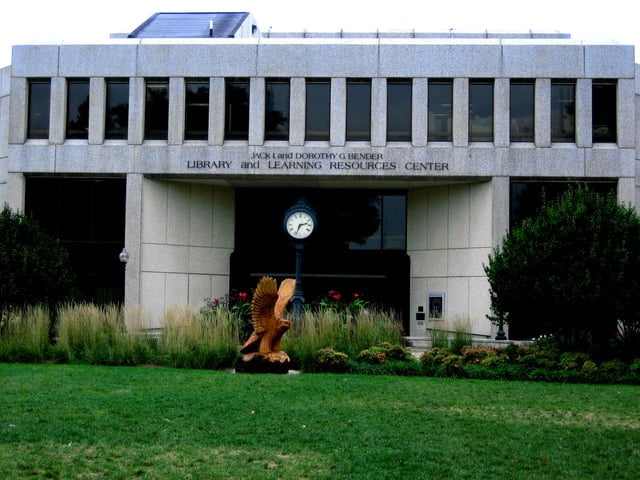
The Jack I. and Dorothy G. Bender Library and Learning Resources Center sits at the top of the Eric Friedheim Quadrangle.
The Jack I. and Dorothy G. Bender Library and Learning Resources Center is the main library facility for the campus.
A branch Music Library is located in the Katzen Art Center.
The Pence Law Library, part of AU's Washington College of Law, operates separately from the main library system.
The University Library is part of the Washington Research Library Consortium (WRLC), which includes seven other libraries.
The WRLC operates a consortium loan service between member institutions and has a shared collections site in Upper Marlboro, Maryland.
The Bender Library provides a variety of individual and group study spaces and includes a Curriculum Materials Center, a New Media Center, Graduate Research Center, classrooms, and a café.
About 160 public computer workstations are available throughout the Bender building and researchers also may borrow laptops, chargers, tablets, and other electronic devices.
In October 2012, the library acquired a large poster printer which researchers may use for presentations and other academic purposes.
The Library's Archives and Special Collections houses unique and rare materials and information on the history of the institution.
The University Archives is the repository for papers and other documents, including sound recordings and photographs, spanning more than a century of the university's history.
Special Collections houses rare materials.
Among the more important holdings are the Artemas Martin collection of mathematical texts, the Charles Nelson Spinks collection of artistic and historical works of Japan, the Irwin M. Heine collection of literary works, and Christopher Johnson collection of William Faulkner books. Playbills form a significant set of the collections with the James Carroll and Iris Lipkowitz collections most notable among them. Other significant collections include the Barlett & Steele Archive, the John R. Hickman Collection, the Friends of Colombia Archives, the Records of the National Peace Corps Association, the Records of the National Commission on the Public Service, the Sally L. Smith Papers, and the Records of Women Strike for Peace.[57]
Campus life
AU has over 240 recognized organizations on campus, ranging from political and social.
The Student Union Board (SUB), a part of the Student Government, is AU's oldest student-run organization.
Since 1963, the SUB has arranged big name concerts and live entertainment for AU.
Acts have ranged from the Grateful Dead to Ben Folds. Past acts include Bob Dylan, Nirvana, Red Hot Chili Peppers, Andrew W.K., Phantom Planet, Everclear, Ben Kweller, Jimmy Eat World, Paramore, Stephen Lynch, Jim Gaffigan, Snow Patrol, Ghostface Killah, Ted Leo and the Pharmacists, Blackalicious, Metro Boomin, and Hayley Kiyoko. SUB also screens free second-run movies for the AU community, known as SUB Cinema.
American University also has an internationally top-ranked Model United Nations team, which competes actively at intercollegiate tournaments, and also hosts yearly High School Model UN competitions on campus.[58]
AU has eight student-run university-recognized media organizations.
These media organizations are governed by a Student Media Board and are funded through the university's undergraduate student activity fee:[59]
Religious life
While American University is affiliated with the United Methodist Church, it also has many organizations that serve students of other religions.
In addition to the AU United Methodist Community,[63] American University has a variety of religious life groups, including Chabad Lubavitch of the AU Community,[64] American University Hillel,[65] the Jewish Student Association,[66] and many others.
Greek life
North American Interfraternity Conference
Multicultural Greek Council Alpha Nu Omega Lambda Pi Chi Gamma Rho Lambda LUNA
Independent Alpha Kappa Pi Alpha Kappa Psi Alpha Phi Omega Delta Kappa Alpha Delta Phi Epsilon Mu Beta Psi Phi Alpha Delta Phi Sigma Pi
Sustainability
American University has an Environmental Issues Project Team to recommend steps about how to fulfill the university's responsibility to protect the environment to the administration.
The Team also works to increase environmental awareness on campus.[69] Student environmental activism has grown into a major presence on American's campus.
The student environmental group, EcoSense, works with regional and national organizations such as the Chesapeake Climate Action Network, The Campus Climate Challenge, Energy Action Network, Step It Up 2007, DC Woodlands, Power Shift, and the DC Youth Environmental Alliance.[70] An environmental science class at American conducted a study from February to April 2009 to measure the amount of food waste avoided by eliminating trays from one of the college's dining halls. The class found that trayless dinners resulted in 47.1% less solid waste than dinners during which trays were used, spurring a student-driven campaign to go trayless across campus.[71] The university's overall grade on the College Sustainability Report Card improved dramatically between 2008 and 2009 from a "D+" to a "B-", demonstrating the university's commitment to environmental responsibility.[72]
In 2011, the Association for the Advancement of Sustainability in Higher Education (AASHE) awarded American University a gold rating, the highest possible, on their STARS scale for sustainability.
In the same year American University's School of International Service building received the Leadership in Energy and Environmental Design (LEED) Gold certification for its 70,000 square foot building that is renowned for sustainable design and "cradle-to-cradle" philosophy.[73]
In 2014, American University ranked #2 in the Sierra Club's list of the 'Top 10 Greenest Colleges'.[74]
In 2018, American University became the first university in the United States to achieve carbon neutral status.[77]
Athletics
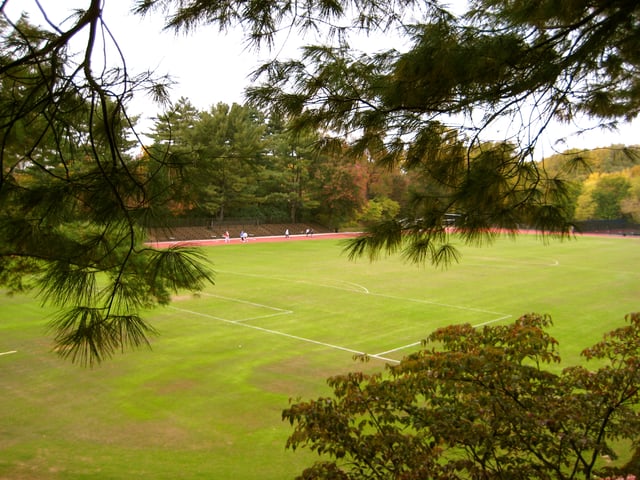
Reeves Field – AU
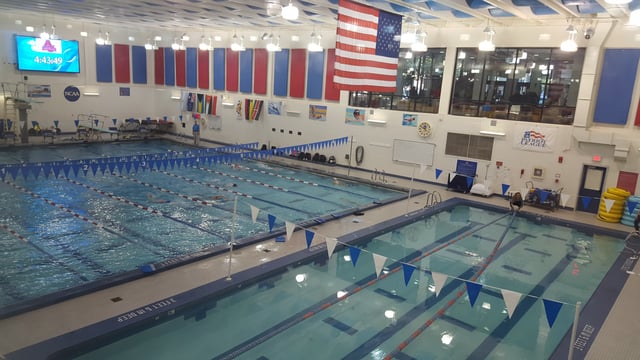
Olympic size swimming pool located in the Reeves Aquatic Center
A member of the Patriot League,[78] AU has several sports teams including men's and women's basketball, soccer, cross-country, swimming & diving, track, women's volleyball, field hockey, and lacrosse, and men's wrestling. Club sports, such as rugby, rowing, ice hockey, field hockey, equestrian and ultimate frisbee also have teams. AU's football team had their last season in 1941.
Bender Arena, a multi-purpose facility, hosts many of American's athletic competitions. Bender Arena opened its doors on January 23, 1988, when AU's women's basketball team hosted James Madison University.
Reeves Field, home to AU's soccer team, earned the 2002 College Soccer Field of the Year by the Sports Turf Managers Association, hosted its fifth NCAA Tournament game, and served as the training site for the Uruguayan national football team. Reeves Field features a six-lane track to accommodate the track and field programs at AU and functions as a multi-purpose event site.
American University has seven tennis courts and two basketball courts complete in the outdoor recreational facility located next to Reeves Field and behind Bender Arena. AU has hosted Patriot League tennis team championships three times since joining the league. Both the men's and women's tennis teams have been cut from the athletics program.
On March 14, 2008, AU earned its first NCAA Tournament berth in men's basketball by defeating Colgate University in the Patriot League Championship Game. However, AU lost its first-round NCAA tournament game against the University of Tennessee. On March 13, 2009 AU's men's basketball team repeated as Patriot League Champion by defeating Holy Cross 73–57, earning an automatic bid to the NCAA Men's Division I Basketball Championship. They ultimately lost to Villanova University in the first round on March 19, 2009 with a final score of 80–67.
American University Television
American University Television (ATV) is a student-run organization based at American University.
The station's programming runs through the residence halls and throughout campus on channels 2 and 15, as well as streaming content online.[80]
History
ATV was founded in 1979 as WAVE-TV to serve as a new media outlet for AU students beyond the existing student newspaper and radio station.
In 1981, WAVE-TV was formally recognized by the AU Student Confederation, and began full operation as a campus wide closed circuit television station, which broadcast three nights a week.
WAVE-TV was funded by the Student Confederation and by local advertisers.
In 1989, WAVE-TV was renamed to American Television (A-TV2, later shortened to ATV).
Over the course of the 1990s, ATV became available to televisions in student residence hall rooms, and significantly expanded its programming.
In 1996, ATV was recognized by the Society of Professional Journalists, receiving the Mark of Excellence award in sports reporting and overall newscast.
Until the early 2000s, ATV filmed most of its shows in the SOC Media Production Center.
Following AU's renovation of the Mary Graydon Center in 2002, ATV moved into a new dedicated studio and office space on MGC's second floor, outfitted with cameras and equipment donated to the station by AU alumni Norman and Mary Klotz ('76, '79).
Shortly after the move, ATV began broadcasting its programs 24 hours a day, 7 days a week for the first time.
ATV launched its first dedicated website in 2007, and launched an online live-stream simulcast of its on-campus broadcast in 2009, expanding the reach of the station's programming beyond an on-campus student audience for the first time.
Most of ATV's viewers are now online.
In 2011, ATV launched an innovative new rebranding campaign, along with a new logo and station imaging, bringing greater campus visibility to ATV's programming and participation opportunities.[81]
Programming
ATV News
ATV News provides the latest news both around campus and around the Washington, D. C., area. The weekly news program provides student-run coverage about politics, sports, entertainment, and weather.[82]
ATV Special Broadcast
ATV Special Broadcast gives exclusive interviews with guests from the Kennedy Political Union and the Student Union Board.[83]
ATV Shortz
ATV Shortz features episodic student-created short sketches.[84]
Rapid Fire
Rapid Fire is a compilation of student-created comedic skits, with each skit being roughly 10 to 30 seconds long.[85]
The American Dream
SportsZone
SportsZone has a group of panelists discuss the latest sports news where they make predictions and cover campus athletics.[88]
Superheroes Registered
Superheroes Registered is an episodic crime drama about conflicts between superheroes and villains vying for control of the city. It shows the real-life implications of a world of superheroes and villains. Similar to the style of Marvel's recent films, the show can be a serious drama, but has playful aspects as well.[89]
ATV in the TAV
ATV in the TAV is a variety show in the vein of Saturday Night Live that features the best content of ATV. It is broadcast in the Tavern at 7:00 p.m. every other Tuesday.[90]
Retired shows
The After Party
Capitol Politics
I Have News for AU
Midnight with Chris Noll
Midnight with Kurt Lustgarten
The Pr0n Show
Screening Room
Solidarity TV
tech tAUk [91]
Uncle Sketch
Notable people
Notable alumni of American University include:
Washington D.C. mayor Muriel Bowser
President of the Republic of Sierra Leone Julius Maada Bio
Broadcaster David Aldridge[92]
Iraqi Kurdistan intelligence/security director Masrour Barzani
American novelist Ann Beattie
American author Max Brooks
US Senator Robert Byrd
CNN anchor Alisyn Camerota
Fox News TV anchor and journalist Neil Cavuto
Blackboard Inc. co-founder Michael Chasen
Attorney and spokesperson for U.S.
President Donald Trump, Michael Cohen[93]
Director of the National Economic Council (United States) and former President of Goldman Sachs Gary Cohn
CEO of the Democratic National Committee Amy Dacey
YouTube personality Jack Douglass
Acoustic guitarist John Fahey, credited with creating the American primitive guitar style
NBC anchor of Meet the Press David Gregory
Bahraini Crown Prince Salman bin Hamad bin Isa Al Khalifa
Essayist and author Florence King
American actress Goldie Hawn
American psychologist, suicidologist, and an advocate for the LGBT community, Michael Hendricks
NBA player for the Los Angeles Lakers Andre Ingram
TV personality Star Jones
Former Missouri Secretary of State and 2016 Senate Candidate Jason Kander
Fox News senior correspondent Rick Leventhal
American screenwriter Barry Levinson
Ethiopian prince Joel Dawit Makonnen
Filmmaker Nancy Meyers
Prime Minister of Grenada Keith Mitchell
Congresswoman Connie Morella
White House Director of Communications Jennifer Palmieri
Suffragist leader Alice Paul
Blackboard Inc. co-founder Matthew Pittinsky
Human rights activist John Prendergast
Libertarian Party chairman Nicholas Sarwark
C-SPAN journalist Steve Scully
TV personality Judy Sheindlin ("Judge Judy")
Crisis Manager, former Deputy Press Secretary of the White House and TV Producer Judy Smith
Former NBA player Kermit Washington
Belarus political activist Franak Viacorka
Russian spy Maria Butina
Afghani rapper and activist Sonita Alizadeh
The Wolf of Wall Street Jordan Belfort
American counter-terrorism expert John P. O'Neill
Since 1947, American University has operated a Washington Semester Program, which allows students to learn about public policy and experience the nation's capital from its campus.
Program alumni include former US House Speaker Paul Ryan, 1988 Democratic presidential nominee Michael Dukakis, former US Secretary of Health and Human Services Donna Shalala, former US Senator Max Cleland, former US congressmen Jim Nussle and Paul McHale, and 2012 Obama for America deputy campaign director Stephanie Cutter.[94]
